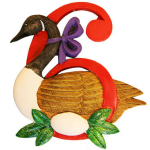 Day 6. Making multiple-choice better. Although I don’t, in general, much like multiple-choice questions, I have to admit that they can sometimes work very well. In conventional face-to-face settings, the use of electronic voting systems (‘clickers’) can bring lectures alive as well as informing lecturers about student misunderstandings. And it gets better – we don’t have conventional lectures at the Open University, but we are making more and more use of synchronous conferencing tools such as Elluminate Live! (now Blackboard Collaborate elsewhere) – which has a quiz function. I have seen the quiz function used most effectively to make Elluminate sessions much more interactive.
Day 6. Making multiple-choice better. Although I don’t, in general, much like multiple-choice questions, I have to admit that they can sometimes work very well. In conventional face-to-face settings, the use of electronic voting systems (‘clickers’) can bring lectures alive as well as informing lecturers about student misunderstandings. And it gets better – we don’t have conventional lectures at the Open University, but we are making more and more use of synchronous conferencing tools such as Elluminate Live! (now Blackboard Collaborate elsewhere) – which has a quiz function. I have seen the quiz function used most effectively to make Elluminate sessions much more interactive.
Another way in which multiple-choice questions can be most effective is to get students to write them, perhaps using a tool such as Peerwise.
But let’s retrun to the more conventional use of online quizzes as assessment. In order to make multiple-choice eAssessment as effective as possible, it seems sensible to start by checking that everything has been done to improve the quality of the questions themselves i.e. that we don’t have to worry about things like having options that are opposites or where a clue is provided by the fact that the grammatical construction of the stem of the question that doesn’t fit with some of the options.
I am not a fan of negative marking for incorrectly selected options, because I feel that you’re then assessing students’ risk taking strategy as much as their knowledge and skills, and negative marking does not provide a direct way of dealing with answers that are correct by guesswork or incorrect because of a slip rather than a fundamental error. However, despite some reservations, I have come round to the idea of confidence-based marking (also known as certainty-based marking) in which students state both an answer and their confidence in it (and get more credit for a correct and confidently stated answer than for a correct and inconfidently stated answer, but also receive more penalty for an incorrect and confidently stated answer than for an incorrect and inconfidently stated answer). Other ‘clever’ uses of multiple choice include negative marking for incorrect responses coupled with allowing students to select two or three options if they are not sure which is correct – so they get most credit for a single correct response, but some credit (calculated by way of full credit for the correct option and a smaller negative mark for the incorrect one) for knowing that the correct response is one of two.
Mutliple choice questions can also be effective when students are given the opportunity to explain their answers or to reflect on the process.
